Center for Community Support and Development Studies, Real-Time Analytics and United Nations Development Program
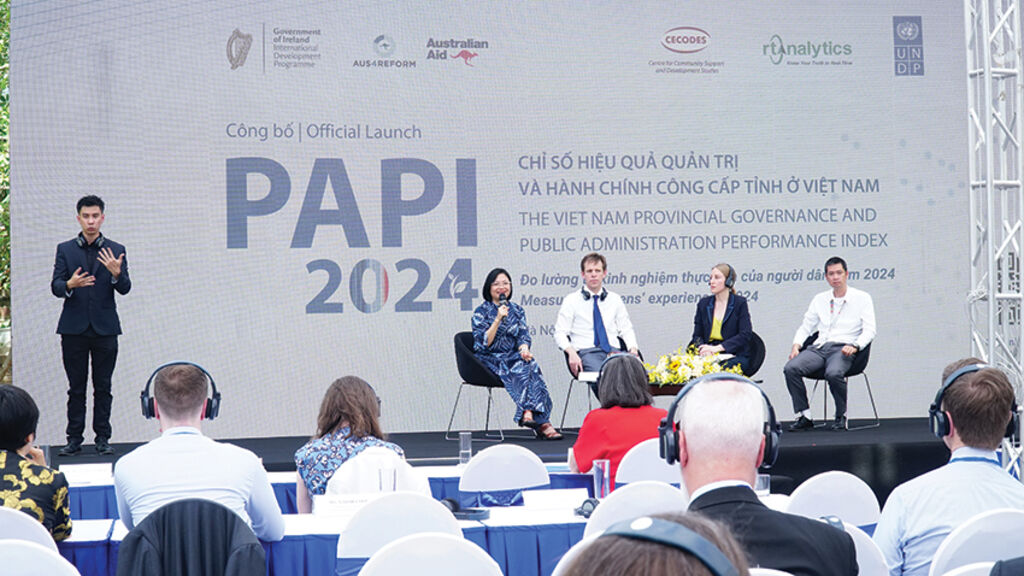 |
| Panel Discussion on 2024 PAPI Findings at the Official Launch on April 15__Photo: Nguyen Thu Thao/UNDP |
Introduction
The newly released 2024 Provincial Governance and Public Administration Performance Index (PAPI)[1] reveals encouraging progress across several dimensions of local governance. However, the findings also underscore persistent demographic and geographic gaps in citizen satisfaction, with women, ethnic minorities, migrants and residents of rural and more remote areas consistently reporting lower levels of service.
This article is an excerpt from the 2024 PAPI Report, which was officially launched on April 15, and presents key findings from PAPI citizen surveys regarding citizens’ assessment of governance and public administration performance at the national level and the issues of citizens’ greatest concern in 2024. The Report records the voices of 18,894 randomly selected respondents aged 18 years and above, from various demographic backgrounds across Vietnam. The respondents shared their perspectives of local government performance in governance, public administration and public service delivery in 2024.
This article starts by highlighting national trends in all eight PAPI dimensions from 2021 to 2024 to reveal how the Government performed in their fourth year of the current 2016-21 term from the perspective of all respondents and by gender, ethnicity and migration status. Then it reflects citizens’ issues of most concern in 2024, the year when Vietnam was hit hard by Typhoon Yagi, and over the past eight years. It concludes by summarizing key findings of immediate interest for different stakeholders involved in governance and public administration in Vietnam. It also points to policy implications relevant for policymakers and practitioners in Vietnam in 2025 and beyond.
Governance and public administration performance in 2024: steps forward, but pace of progress needs to accelerate
This section provides a summary of the key findings and implications from the analysis of the 2024 PAPI survey results, with a focus on the performance of national level governance and public administration from a comparative perspective. First, it brings forward time-series comparisons of dimensions consistently measured from 2021 to 2024. Second, it examines in greater detail the two dimensions of Control of Corruption in the Public Sector and E-Governance which are critical to overall citizen satisfaction with government performance at different levels, especially when Vietnam decides to accelerate digital transformation in the public sector, reconfirmed by the issuance of Politburo’s Resolution 57-NQ/TW on breakthrough development of science, technology, innovation, and national digital transformation[2].
As shown in Figure 1, in 2024, citizens reported greater satisfaction with governance and public administration, highlighting improvements in transparency in local decision-making, control of corruption in the public sector, environmental governance, and e-governance. However, despite these gains, significant opportunities remain to further enhance governance performance. Only three of eight dimensions measured by PAPI - control of corruption in the public sector, public administrative procedures, and public service delivery - achieve high citizen scores nationwide. That said, five dimensions - namely participation at the local levels, transparency in local decision-making, vertical accountability toward citizens, environmental governance, and e-governance - continue to register overall low citizen satisfaction scores despite year-on-year improvements, highlighting significant opportunities for improvement, as indicated by the orange dashed line showing the average score of the scale from 1 to 10 points.
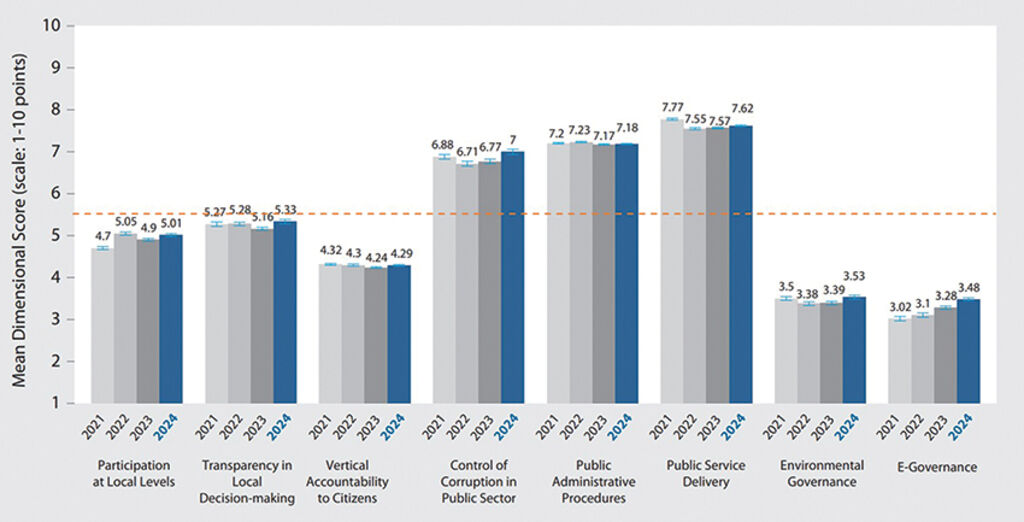 |
| Figure 1: Overall changes in PAPI dimensional scores over time, 2021-24 |
Despite the overall progress, disparities in governance satisfaction persist across gender, ethnicity and migration status. Women consistently rated governance lower than men, particularly in terms of participation and transparency in local decision-making. As Figure 2 shows, women rated governance more negatively than men across all dimensions - most pronounced in Dimension 1 (Participation at Local Levels). This is largely due to women’s lower reported awareness of political institutions and participation in elections than men. Women also scored Dimension 2 (Transparency in Local Decision-Making) lower as they were less likely to access information about commune budgets and land use plans. Similarly, they were less likely to access the Internet, which negatively impacted scores on Dimension 8 (E-Governance).
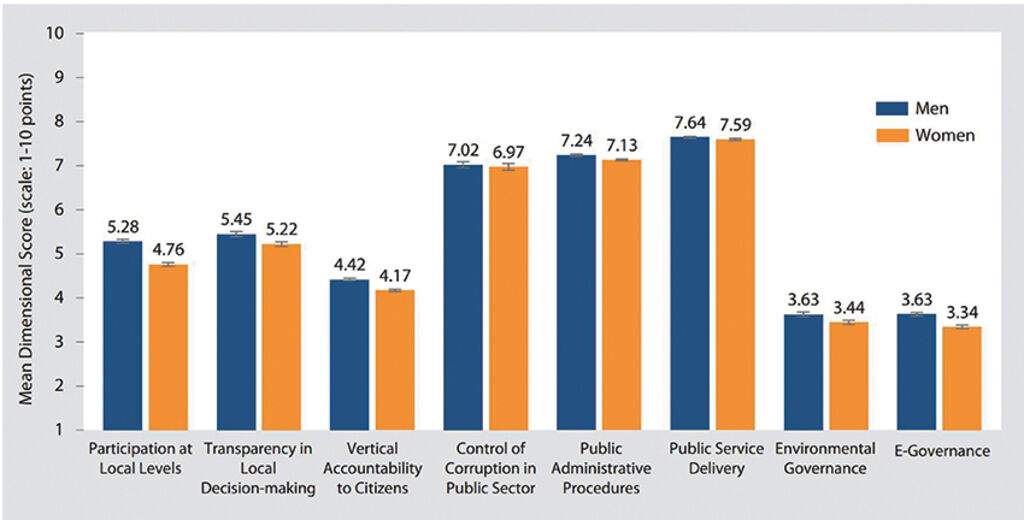 |
| Figure 2: Overall PAPI dimensional scores by gender, 2024 |
Ethnic minority groups also reported lower satisfaction across multiple dimensions, while non-permanent residents, especially in migrant-receiving provinces, faced limited access to public services. Figure 3 shows similar disparities between ethnic majority Kinh and ethnic minorities. With the exception of Dimension 5 (Public Administrative Procedures) and Dimension 7 (Environmental Governance), ethnic minorities gave lower scores to the six other PAPI dimensions, especially Participation at Local Levels, Transparency in Local Decision-Making, Control of Corruption in the Public Sector, and E-Governance.
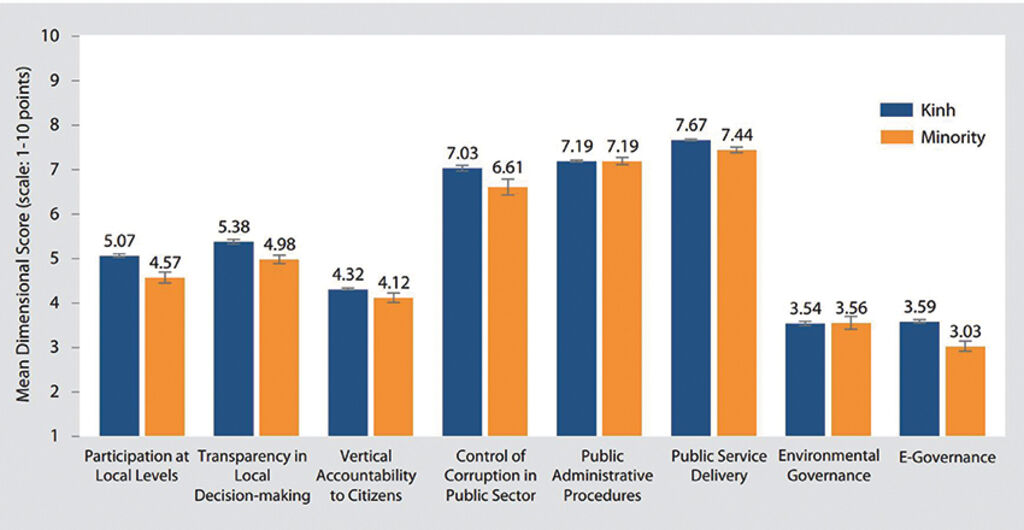 |
| Figure 3: Overall PAPI dimensional scores by ethnicity, 2024 |
Governance and public administration performance as experienced by non-permanent residents remained a mixed bag in 10 migrant-receiving provinces in 2024. The largest disparities between permanent and non-permanent residents are seen in Hanoi, Dak Nong, Dong Nai, Ho Chi Minh City and Long An (Figure 4), with a levelling up in Ba Ria Vung Tau and Thai Nguyen. The gaps suggest that migrant-receiving provinces need to do more to ensure equitable access to governance and public administration systems in their provinces and empower migrants to feel welcome and motivated to contribute to local development.
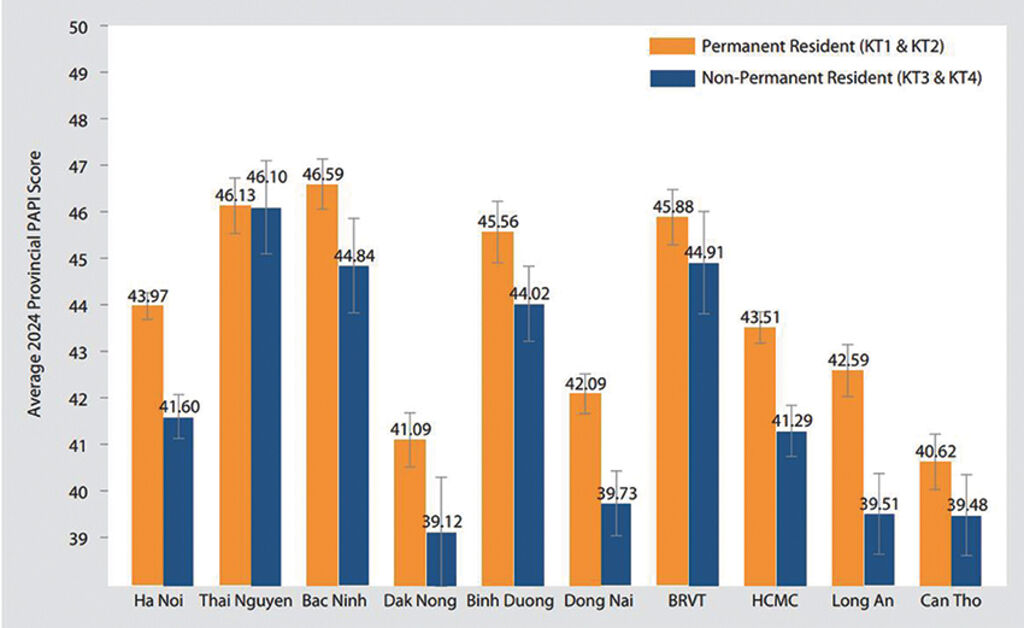 |
| Figure 4: Levels of differences in governance and public administration as experienced by non-permanent residents vary across migrant-receiving provinces in 2024 |
As Figure 1 shows, control of corruption in the public sector improved in 2024. As Figure 5 demonstrates, scores across all four sub-dimensions of the Control of Corruption in the Public Sector dimension were higher than in the previous three years. Since 2009, PAPI has annually assessed four key aspects related to local anti-corruption efforts: limits on corruption in local government, limits on corruption in the broader public sector, equity in state employment, and willingness to fight corruption. Even the Willingness to Fight Corruption sub-dimension, which had declined since 2021, rebounded to 1.99 points in 2024. The second-largest increase among the four sub-dimensions was in the Equity in State Employment sub-dimension, suggesting citizen recognition of stronger government efforts to control bribery and nepotism in public sector hiring in 2024.
Regarding equity in state employment, aside from declining respondents aware of bribery for public sector jobs as Figure 6 shows, there was a reduction in the proportion of citizens who believed State connections are important to gain a public office position (land registrars, justice officers, police officers, primary school teachers, and commune-level People’s Committee staff). This trend has been continuous since 2017 when the anti-corruption campaign further accelerated. However, the figure also reveals a high level of citizen concern about the importance of nepotism and personal connections required when applying for one of five positions, with the percentages of respondents seeing nepotism as a key success factor ranging from 56 to 61 percent. In particular, the highest levels of concern about nepotism are focused on land registrars and justice officers, with more than 60 percent of respondents saying connections were important.
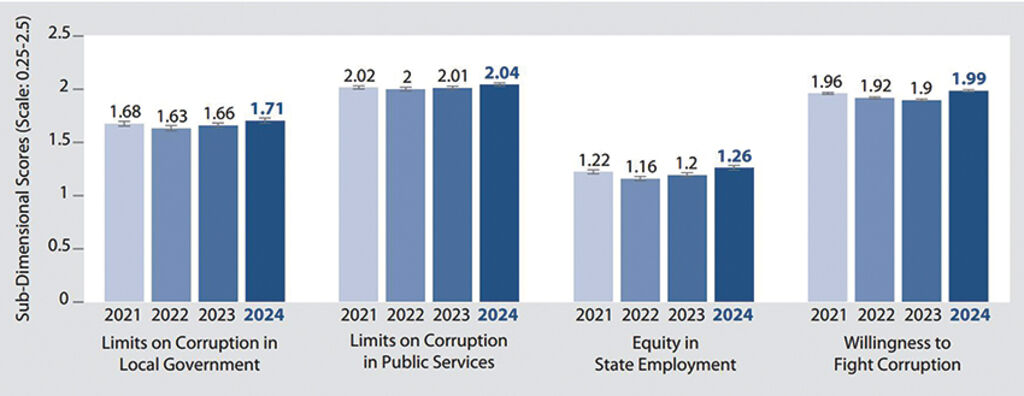 |
| Figure 5: Trend in sub-dimensions of the Control of Corruption in the Public Sector dimension, 2021-24 |
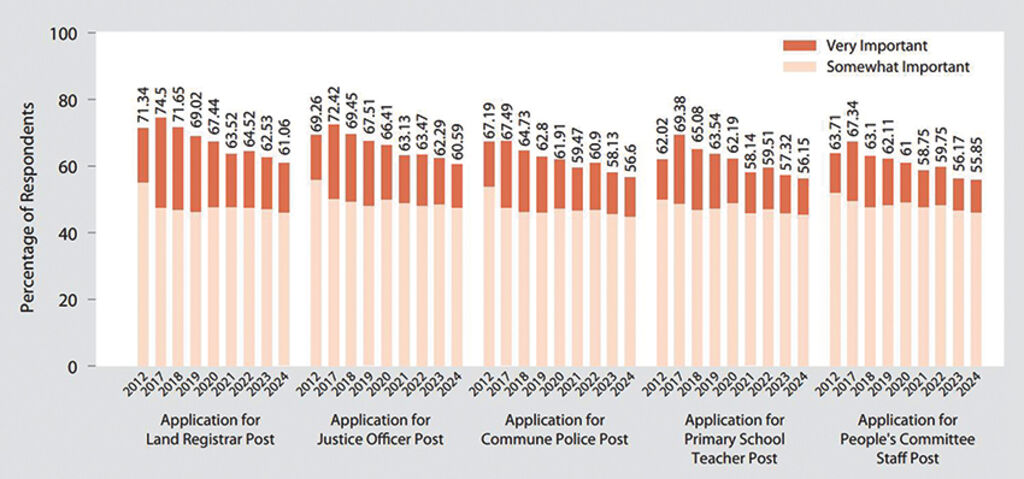 |
| Figure 6: Trend in citizen perception of the importance of connections for selected civil service positions, 2012-24 |
Figure 7 features the results from estimating the number of citizens who engage in giving a bribe when applying for land use rights certificates (LURCs), obtaining better treatment at public district hospitals, or obtaining teachers’ favoritism for children attending public primary schools.[3] They reveal that incidences of bribery for better healthcare further shrank in 2024 compared to the previous three years. Regarding informal payments for teachers’ favoritism, there was a sharp decline in 2024 compared to a year earlier. However, bribery experienced for LURCs became more prevalent in 2024, with a 5 percent rise to 20 percent. This may explain why nepotism for the post of land registry civil servants remains prevalent.
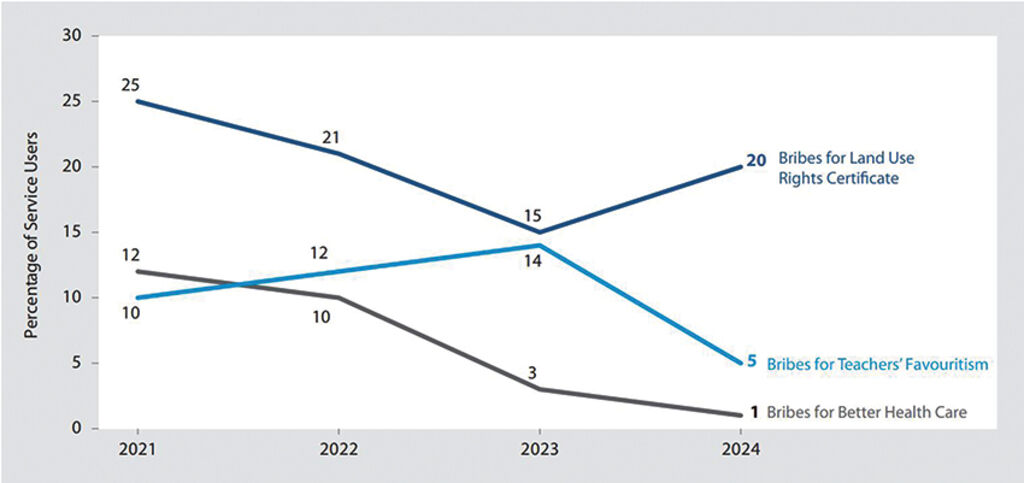 |
| Figure 7: Estimated bribe frequency for public services as experienced by users, 2021-24 |
Top ten issues of greatest concern for citizens in 2024 and over time: easing concerns about poverty contrast with worsening sentiment about corruption
This section captures citizens’ assessments of household economic conditions in 2024, also with a time-series perspective from 2015. The findings are important as they provide context to analyze the shifts in important PAPI scores in this Report. They also provide a snapshot of which key policy priorities the central and local governments should address in the following year from citizens’ perspectives.
Corruption emerged as the top citizen concern, despite significant improvements in control of corruption. As Figure 8 shows, in 2024, corruption overtook poverty and hunger as the top issue of concern for Vietnamese citizens, with a record 22.58 percent of respondents identifying it as the top priority for government action. This shift comes despite visible progress in the Control of Corruption in the Public Sector dimension at the local level, where fewer citizens reported paying bribes for services compared to 2023 as presented earlier. However, perceptions of improvements locally contrast with heightened overall concern, likely fueled by ongoing high-profile corruption cases and the visibility of the government’s intensified national anti-corruption campaign.
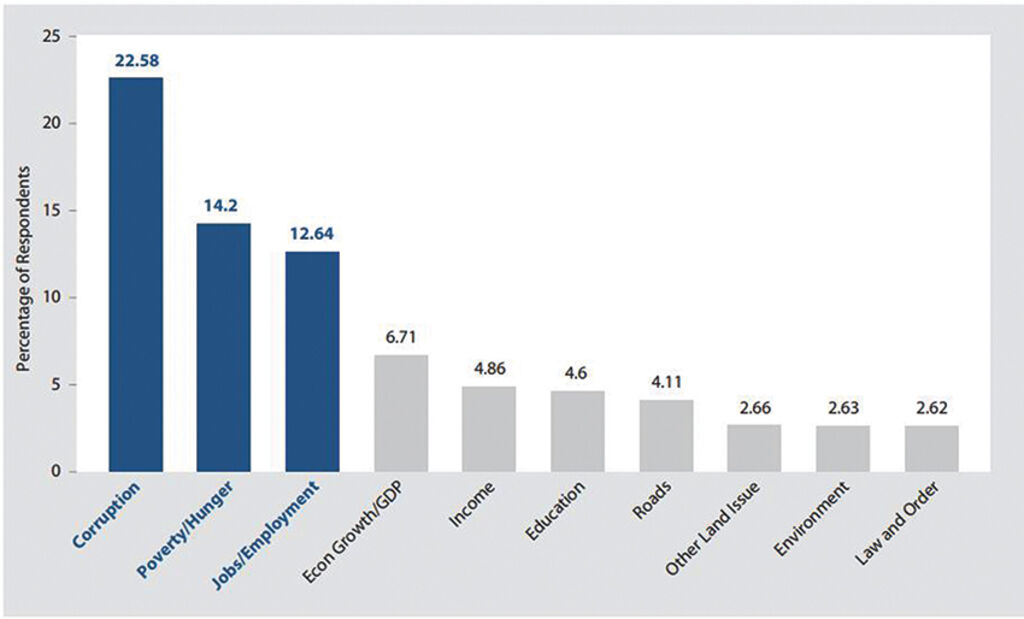 |
| Figure 8: Top ten important issues from citizens’ perspectives in 2024 |
Figure 9 further shows the trend in citizen priorities from 2015, when the question about three issues of greatest concern that would come to the respondents’ mind was first asked, to 2024. The figure tracks how five selected issues of concern - poverty/hunger, corruption, jobs/employment, health, and environment - have changed since the question was first asked in 2015. It highlights the dramatic 17 percentage point swing in concern about corruption relative to 2023 in contrast to an eight-percentage point decrease for poverty (see Figure 9). As context to this shift, Vietnam’s economic performance improved in 2024 compared to 2023, while the government’s high-profile crusade against corruption further gathered steam in 2024. The graph also shows a consistent drop in citizens’ prioritization of healthcare and health insurance since the height of the pandemic. Concern about environmental pollution increased slightly in 2024, as more citizens called for the State’s action to address environmental challenges in 2024 than in the previous three years.
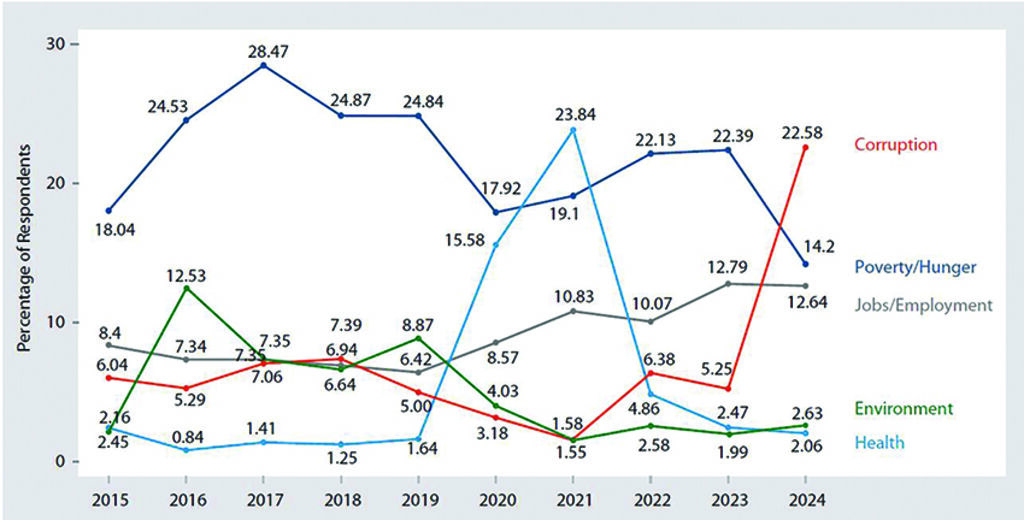 |
| Figure 9: Changes in five selected issues of greatest concern, 2015-24 |
Two primary dynamics are potentially at play and underpinning these contrasting citizen views of poverty and corruption. One possibility is that poverty is viewed as less of a concern because economic headwinds eased in 2024. As reported by the General Statistics Office (GSO), national GDP grew by 7.09 percent in 2024, with an increasing pace observed across the four quarters (5.98, 7.25, 7.43 and 7.55 percent, respectively). Manufacturing, construction, and services contributed to this growth during the second half of 2024 when the PAPI survey was conducted. Moreover, according to the GSO, the 2024’s fourth quarter unemployment rate was 1.65 percent, down from 1.98 percent in 2023. Additionally, the multi-dimensional poverty rate for 2024 was reported at 2.4 percent - indicating a one-percentage point decline compared to 2023. Regarding corruption, it is possible that high-profile cases reported frequently in the media throughout 2024 may have elevated the issue in the public consciousness, which will be further explored in this chapter.
Improving economic indicators are further reflected in 2024 PAPI survey data. Each year, the PAPI survey asks respondents how they rate their current household economic situation, and how they assess Vietnam’s economic situation at the time they are asked the question. As Figures 10 and 11 show, there was greater positivity in citizens’ assessment of their household and perceived national economic situations in 2024 than 2023. As shown in Figure 10, the percentage of respondents who indicated their household’s economic situation in 2024 was “poor” or “very poor” dropped to its lowest level at 10.2 percent since 2019 (10 percent), prior to the pandemic’s economic impacts from 2020 to 2021. Additionally, a marked increase in respondents characterized Vietnam’s current economic situation as “good” - rising from 54 percent in 2023 to 63 percent in 2024 (see Figure 11).
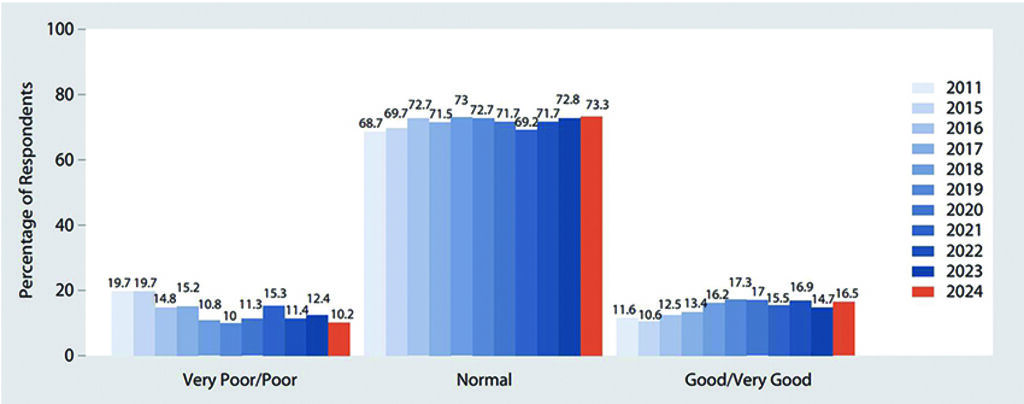 |
| Figure 10: Citizens’ assessment of current household economic situation, 2011-24 |
This notwithstanding, poverty and hunger emerged as the second most critical concern for citizens (14.2 percent), followed closely by jobs and employment (12.64 percent). Despite Vietnam’s robust economic growth in 2024, economic insecurity remains a pressing issue, particularly for vulnerable populations. The report highlights a strong - and unsurprising - correlation between perceptions of household economic well-being and access to social insurance.
In 2024, the PAPI survey further examined access to social insurance by citizens. Drawing on data from PAPI surveys over time, the survey findings show that coverage widens but remains low. Figure 12 underlines this trend, showing an 8 percent increase in coverage emerged in six years from 2019 (21 percent) to 2024 (29.43 percent).
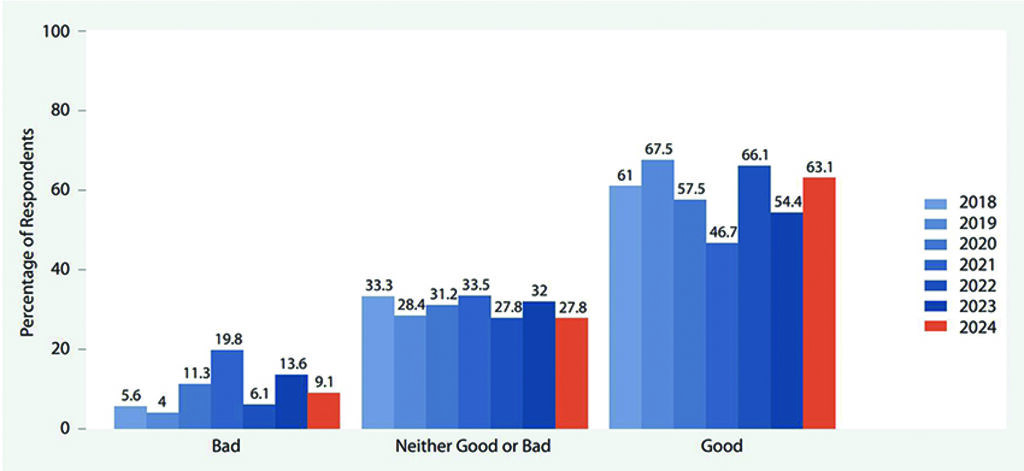 |
| Figure 11: Citizens’ assessment of Vietnam’s annual overall economy, 2018-24 |
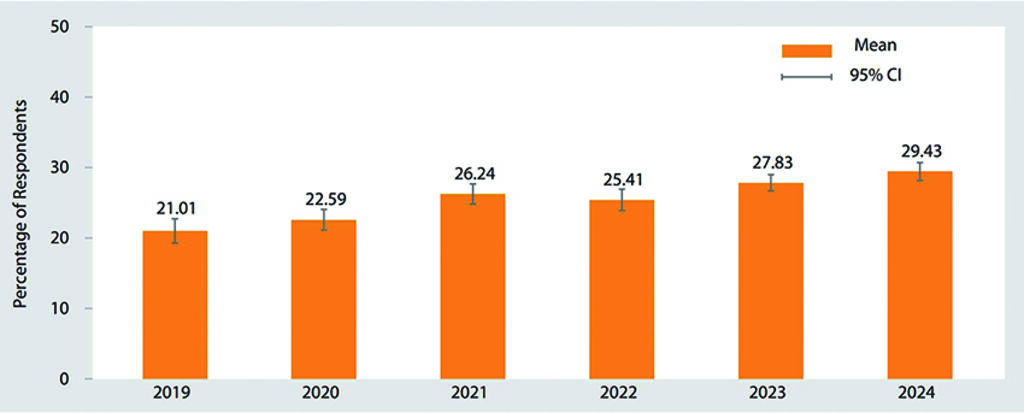 |
| Figure 12: Percentage of respondents with social insurance, 2019-24 |
However, access to social insurance unequally distributed across sectors. As high as 77 percent of respondents in state-owned or government sectors said they had insurance, which contrasts with only 11 percent of those working in agriculture and 15 percent in informal sectors (see Figure 13).
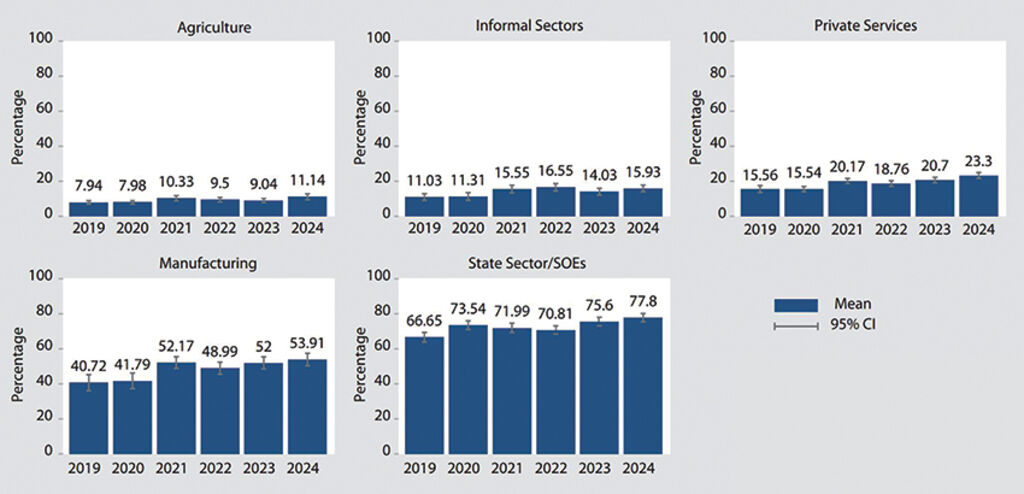 |
| Figure 13: Access to social insurance by economic sector, 2019-24 |
Implications and key takeaways
The 2024 PAPI survey reveals tangible progress in the arena of governance and public administration at the national level. With citizens reporting greater satisfaction with the national and household economy in 2024, this may transcend into more positive perspectives of local government performance. Governance indicators improved across nearly all dimensions. Strikingly, the most pronounced progress was observed in controlling corruption in the public sector and e-governance.
However, challenges persist. Stubborn concerns about corruption remain, and disparities in satisfaction levels among different population groups are evident. Despite more positive perceptions of government efforts to address petty corruption locally, citizens emphasize the need for continued anti-corruption measures. With high-profile arrests in the banking and land development sectors having heightened public awareness of this issue, citizens are positioned to closely monitor the government’s anti-corruption performance as its 2021-26 term concludes.
Further strengthened anti-corruption efforts, through prioritized enhancing transparency and accountability in public institutions, can be achieved through strictly enforcing existing regulations, promoting whistleblower protection mechanisms, and leveraging e-governance to improve oversight and public access to information. Additionally, fostering a culture of integrity within the public sector through open and fair employment, ethics training and leadership commitment is crucial. Land governance, in particular, requires focused reforms to reduce corruption and improve transparency in land planning and LURCs.
In response to disparities in citizen satisfaction levels with local government performance, an increased focus on inclusive governance needs to cater to the needs of all population groups. This includes promoting gender equality in the state apparatus and social inclusion in decision-making processes, ensuring equitable access to public services, and addressing specific concerns of marginalized communities. With the 14th National Party Congress and Election of Deputies to the 16th National Assembly and Deputies to all-level People’s Councils for the 2026-31 tenure looming, increasing the proportion of women, people of diverse sexual orientations, ethnic minorities, and socially marginalized candidates in nomination pools for elections and appointments will enhance their participation in decision-making and representative offices. Continuous monitoring and evaluation of policies and programs are essential to identify and address emerging disparities.
While social insurance coverage has broadened since 2019, its distribution remains uneven across sectors, with limited access for informal workers, migrants, and ethnic minorities. Based on this finding, several solutions are offered. As the new Social Insurance Law comes into force in mid-2025, it is crucial to ensure simplified and transparent application procedures for social insurance schemes, especially voluntary ones, and to widely communicate the benefits of social insurance enrolment. Social insurance coverage can be enhanced when trust in social insurance funds is built and social insurance targets those working in informal sectors, migrant workers, and ethnic minority employees through tailored schemes and accessible registration platforms. More importantly, financial literacy programs and diverse savings mechanisms for citizens in need is crucial to ensure no one is left behind.-
[1] The Vietnam Provincial Governance and Public Administration Performance Index (PAPI) is a policy monitoring tool that assesses citizen experiences and satisfaction with government performance at the national and sub-national levels in governance, public administration and public service delivery. Following the initial pilot in 2009 and a larger survey in 2010, the PAPI survey has been implemented nationwide each year since 2011. In total, 216,673 Vietnamese citizens nationwide have been directly interviewed for PAPI since 2009. PAPI measures eight dimensions: Participation at Local Levels, Transparency in Local Decision-Making, Vertical Accountability Toward Citizens, Control of Corruption in the Public Sector, Public Administrative Procedures, Public Service Delivery, Environmental Governance, and E-Governance. PAPI 2024 was the result of collaboration between the Center for Community Support and Development Studies (CECODES), Real-Time Analytics and the United Nations Development Program (UNDP), with the support for fieldwork coordination from the Vietnam Fatherland Front’s provincial to grassroots chapters. For more information about the PAPI research and reports, visit www.papi.org.vn.
[2] See https://thuvienphapluat.vn/van-ban/Cong-nghe-thong-tin/Nghi-quyet-57-NQ-TW-2024-dot-pha-phat-trien-khoa-hoc-cong-nghe-doi-moi-sang-tao-637245.aspx.
[3] The estimates are derived from a list experiment, a shielded response technique where respondents are given a list of items and asked how many, but not which specific ones, they took part in. Respondents are randomly assigned to two lists. The first list contains four non-sensitive items that are easy to answer, while the second list contains non-sensitive items plus sensitive list questions. The difference in means between the two groups provides the share engaging in the sensitive activity. This allows respondents to answer a question about bribery without the necessity of admitting to it directly.









